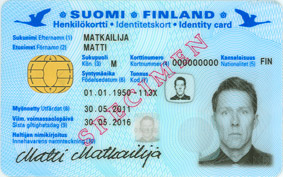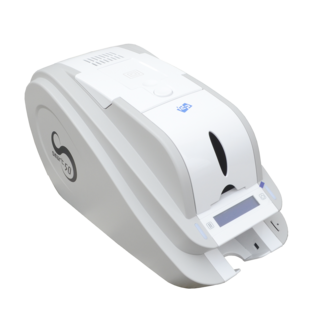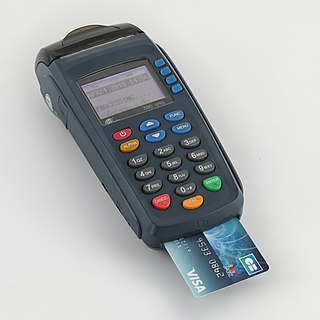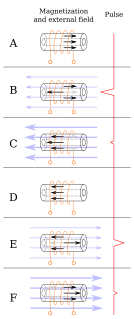
A smart card, chip card, or integrated circuit card (ICC) is a physical electronic authorization device, used to control access to a resource. It is typically a plastic credit card sized card with an embedded integrated circuit. Many smart cards include a pattern of metal contacts to electrically connect to the internal chip. Others are contactless, and some are both. Smart cards can provide personal identification, authentication, data storage, and application processing. Applications include identification, financial, mobile phones (SIM), public transit, computer security, schools, and healthcare. Smart cards may provide strong security authentication for single sign-on (SSO) within organizations. Several nations have deployed smart cards throughout their populations.

A proximity card or prox card is a "contactless" smart card which can be read without inserting it into a reader device, as required by earlier magnetic stripe cards such as credit cards and "contact" type smart cards. The proximity cards are part of the contactless card technologies. Held near an electronic reader for a moment they enable the identification of an encoded number. The reader usually produces a beep or other sound to indicate the card has been read.

EMV is a payment method based upon a technical standard for smart payment cards and for payment terminals and automated teller machines that can accept them.
Dip or DIP, may refer to:

Payment cards are part of a payment system issued by financial institutions, such as a bank, to a customer that enables its owner to access the funds in the customer's designated bank accounts, or through a credit account and make payments by electronic funds transfer and access automated teller machines (ATMs). Such cards are known by a variety of names including bank cards, ATM cards, MAC, client cards, key cards or cash cards.
A card reader is a data input device that reads data from a card-shaped storage medium. The first were punched card readers, which read the paper or cardboard punched cards that were used during the first several decades of the computer industry to store information and programs for computer systems. Modern card readers are electronic devices that can read plastic cards embedded with either a barcode, magnetic strip, computer chip or another storage medium.

A contactless smart card is a contactless credential whose dimensions are credit-card size. Its embedded integrated circuits can store data and communicate with a terminal via NFC. Commonplace uses include transit tickets, bank cards and passports.
A keycard lock is a lock operated by a keycard, a flat, rectangular plastic card with identical dimensions to that of a credit card or American and EU driver's license. The card stores a physical or digital pattern that the door mechanism accepts before disengaging the lock.

A card printer is an electronic desktop printer with single card feeders which print and personalize plastic cards. In this respect they differ from, for example, label printers which have a continuous supply feed. Card dimensions are usually 85.60 × 53.98 mm, standardized under ISO/IEC 7810 as ID-1. This format is also used in EC-cards, telephone cards, credit cards, driver's licenses and health insurance cards. This is commonly known as the bank card format. Card printers are controlled by corresponding printer drivers or by means of a specific programming language. Generally card printers are designed with laminating, striping, and punching functions, and use desktop or web-based software. The hardware features of a card printer differentiate a card printer from the more traditional printers, as ID cards are usually made of PVC plastic and require laminating and punching. Different card printers can accept different card thickness and dimensions.

An access badge is a credential used to gain entry to an area having automated access control entry points. Entry points may be doors, turnstiles, parking gates or other barriers.

A payment terminal, also known as a Point of Sale (POS) terminal, credit card terminal, EFTPOS terminal, is a device which interfaces with payment cards to make electronic funds transfers. The terminal typically consists of a secure keypad for entering PIN, a screen, a means of capturing information from payments cards and a network connection to access the payment network for authorization.
An MM code is a "machine-readable modulated" feature that has been added to German debit cards during manufacture as an anti-counterfeiting measure since 1979. It was developed by "Gesellschaft für Automation und Organisation" in Munich for the German ec-Card system and MM verification devices have been added to German ATMs from 1982 onwards. If a payment card contains an MM code as well as a magnetic stripe, any fraudster who counterfeits the card but fails to read and duplicate the MM code onto the copy will be detected when trying to use the counterfeit in a German automated teller machine.
Access-IS develops and manufactures electronic systems designed to accurately capture and transfer information into electronic systems based on 30 years’ experience in image processing, RFID/NFC technology and barcode reading. Access-IS also manufactures specialist keyboards for banking and PoS applications.

The Wiegand effect is a nonlinear magnetic effect, named after its discoverer John R. Wiegand, produced in specially annealed and hardened wire called Wiegand wire.
Cleaning cards are disposable products designed to clean the interior contact points of a device that facilitates an electronic information transaction. In order for the cleaning card to work properly in the device, the card resembles or mimics the material of the transaction media – such as a credit card, check, or currency. As the cleaning card is inserted and passed through the device, it will clean components that would normally come in contact with the transaction media such as readers, lenses, read/write chip and pins, belts, rollers, and paths. Cleaning card products are widely accepted and endorsed by device manufacturers and industry professionals. Many have developed their own cleaning cards to better clean their particular devices.
This is a glossary of terms relating to computer hardware – physical computer hardware, architectural issues, and peripherals.
ISO 9564 is an international standard for personal identification number (PIN) management and security in financial services.

A card security code is a security feature for "card not present" payment card transactions instituted to reduce the incidence of credit card fraud.
Chipless RFID tags are RFID tags that do not require a microchip in the transponder.












